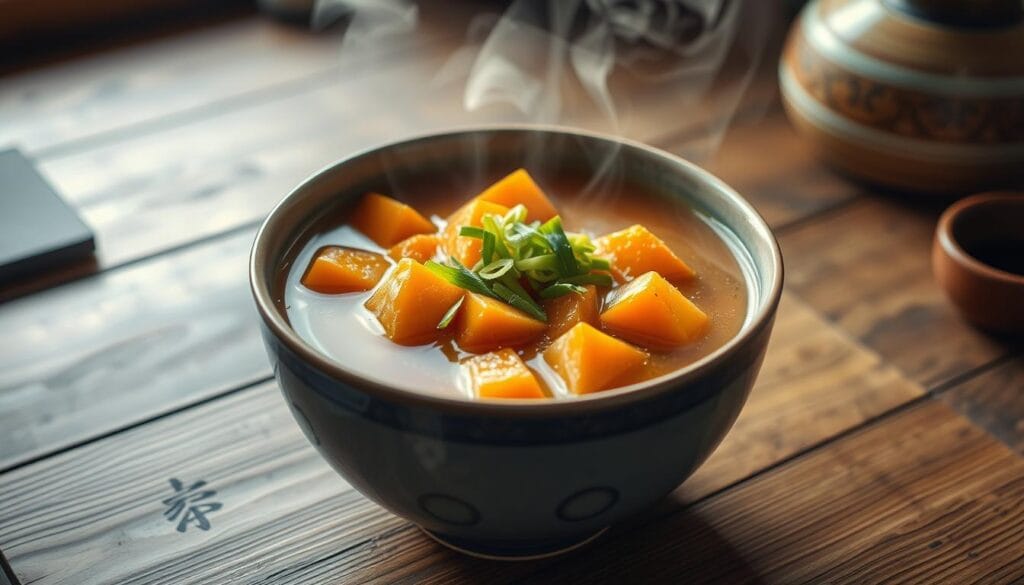Winter’s chill brings a perfect time for a warm bowl of Japanese miso soup. But imagine adding sweet potatoes to this classic dish. It’s a journey that blends the deep flavors of miso with sweet potato miso soup natural sweetness and health benefits.
Growing up in a Japanese-American home, miso soup’s scent was comforting and nostalgic. It had a velvety broth, tender tofu, and sometimes a savory mushroom. This ritual connected me to my heritage and family’s traditions. Later, I found that this simple soup could become something truly special.
Table of Contents
Understanding the Origins of Japanese Miso Soup
Miso soup is a key part of Japanese cuisine. It has deep roots in Japan’s rich food culture. This savory broth, made with fermented miso paste, has changed over time. It shows the cultural and regional diversity of Japan.
Traditional Miso Soup in Japanese Culture
The history of miso soup goes back to ancient Japan. It was first a simple, nourishing dish. The soup was made with dashi broth and miso paste.
This basic recipe became a favorite in Japan. It was often served with rice and other dishes for a balanced meal.
Evolution of Sweet Potato Integration
Chefs and home cooks started adding sweet potatoes to miso soup. Sweet potatoes’ natural sweetness and creamy texture mixed well with miso’s savory flavor. This mix quickly became popular in Japan.
Regional Variations Across Japan
- In northern Japan, where winters are cold, sweet potato miso soup includes ingredients like daikon radish and shiitake mushrooms. These add warmth and nourishment.
- In southern islands, the miso soup might have local seafood like shrimp or clams. This shows the coastal resources.
- Places like Okinawa have their own special versions. They use ingredients like bitter melon or tofu for a unique taste.
These variations show the creativity and adaptability of Japanese cooking. Miso soup is a way to showcase different local flavors and ingredients.
Essential Ingredients for Sweet Potato Miso Soup
Making the perfect sweet potato miso soup needs a mix of key ingredients. These ingredients are at the heart of this comforting Japanese dish. They create its unique flavors and textures.
High-quality miso paste is the base of the soup. Look at the different miso types, like white, yellow, and red. Each has its own fermentation and flavor. The miso you pick will change the soup’s taste a lot.
A good dashi broth is also key. Dashi can be made with kombu and bonito flakes, or you can use shiitake mushrooms for a vegetarian option.
- Sweet potatoes add natural sweetness and creamy texture.
- Tofu, whether silken or firm, adds protein and texture.
- Scallions, mushrooms, and other veggies make the soup richer and prettier.
Choosing and balancing these ingredients well makes a sweet potato miso soup that’s both cozy and full of flavor.
The Perfect Dashi: Building Your Soup Base
At the heart of a mouthwatering dashi broth, the foundation of traditional Japanese miso soup, lies a nuanced balance of umami flavors. Crafting the perfect dashi is an art form. It unlocks the depth and complexity that elevates your vegetarian soup experience.
Kombu and Bonito Flake Basics
The classic dashi broth relies on two key ingredients: kombu, a type of edible kelp, and bonito flakes, created from dried and smoked skipjack tuna. When combined, these ingredients work in harmony. They extract and concentrate the natural umami flavors that are essential to the signature taste of miso soup.
Vegetarian Dashi Alternatives
For those seeking a plant-based approach, a delectable vegetarian soup can still be achieved through the creation of a flavorful dashi. Substitute the bonito flakes with dried shiitake mushrooms or other umami-rich vegetables. This creates a deeply satisfying broth that captures the essence of traditional Japanese cuisine.
Proper Dashi Preparation Techniques
Achieving the perfect dashi broth requires a meticulous approach. Begin by gently simmering the kombu in water, allowing the flavors to slowly infuse. For added depth, incorporate the bonito flakes or vegetarian alternative, carefully timing the extraction process.
With patience and precision, you’ll be rewarded with a soup base. It will elevate your sweet potato miso creation to new heights.
Selecting and Preparing Sweet Potatoes
Choosing the right sweet potato is key for a great miso soup. The right variety and prep can make your meal taste and feel better.
Selecting the Best Sweet Potatoes
Choose sweet potatoes that are firm and have smooth skin. Look for ones that are orange or yellow. These are sweeter and creamier. Stay away from potatoes with soft spots or damage.
| Variety | Flavor Profile | Texture |
|---|---|---|
| Garnet | Sweet, slightly nutty | Moist, creamy |
| Jewel | Sweet, with a subtle spice | Firm, dry |
| Hannah | Mild, earthy | Dry, flaky |
Preparing Sweet Potatoes for the Soup
Start by washing the sweet potatoes well. Use water and a brush to clean the skin. Then, dry them with a towel.
Peel the potatoes if you want a smoother soup. Dice them into small cubes. Make sure they’re all the same size for even cooking.

By picking and prepping your sweet potatoes right, you’ll make a delicious and healthy sweet potato miso soup. It will be a treat for your taste buds.
Choosing the Right Miso Paste for Your Soup
Choosing the right miso paste is key to a delicious sweet potato miso soup. Miso paste, made from fermented soybeans, adds the deep umami flavors that make the soup so comforting. It’s a core part of Japanese cuisine.
White vs. Red vs. Yellow Miso
The world of miso is vast, with three main types:
- White miso is the mildest, with a sweet and delicate taste that pairs well with sweet potatoes.
- Red miso is darker and richer, giving a deeper umami flavor.
- Yellow miso offers a balanced taste, between white and red miso.
Fermentation and Flavor Profiles
Miso’s unique flavors come from a long fermentation process. The longer it ferments, the more complex its taste. White miso ferments for a shorter time, while red miso ferments longer, giving it a deeper flavor.
Storage and Handling Tips
Proper storage and handling of miso are crucial to keep its quality and flavors. Store miso in an airtight container in the fridge. Use clean utensils to avoid contamination. With the right miso, you’ll make a fantastic sweet potato miso soup, celebrating Japanese cuisine.
| Miso Type | Fermentation Duration | Flavor Profile |
|---|---|---|
| White Miso | Shorter | Mild, sweet |
| Red Miso | Longer | Robust, intense umami |
| Yellow Miso | Medium | Balanced, medium-bodied |
Step-by-Step Sweet Potato Miso Soup Recipe
Indulge in the comforting warmth of homemade sweet potato miso soup. This recipe shows you how to make a flavorful, nourishing bowl of Japanese-inspired delight. It’s perfect for a soothing meal or a cozy winter dish.
Ingredients:
- 2 medium-sized sweet potatoes, peeled and diced
- 4 cups of dashi broth (or vegetable broth)
- 2 tablespoons of white miso paste
- 1 cup of sliced shiitake mushrooms
- 2 green onions, thinly sliced
- 1 teaspoon of grated ginger
- Salt and pepper to taste
Start by making the dashi broth as instructed earlier. In a medium saucepan, heat the dashi broth gently over medium heat. Add the diced sweet potatoes and cook until they’re tender, about 10-12 minutes.
After the sweet potatoes are done, lower the heat to low. Stir in the white miso paste until it’s fully mixed. Then, gently add the sliced shiitake mushrooms, green onions, and grated ginger. Season with salt and pepper to taste.
Serve the sweet potato miso soup hot. You can garnish it with more green onions or sesame seeds. Pair it with steamed rice or a crisp salad for a complete meal.

Enjoy the rich flavor and nourishing qualities of this sweet potato miso soup. It’s the ideal comfort food for a chilly day or to share with loved ones.
Nutritional Benefits and Health Properties
Sweet Potato Miso Soup is more than just a tasty dish. It’s packed with nutrients that help keep you healthy. Let’s explore why this Japanese soup is a nutritious meal.
Sweet Potato Health Benefits
Sweet potatoes are full of vitamin A. One cup gives you over 400% of what you need daily. Vitamin A is great for your eyes, immune system, and skin.
They also have lots of dietary fiber. Fiber helps with digestion and keeps you feeling full. This makes the soup a health benefits-rich choice.
Probiotic Properties of Miso
Miso, a fermented soybean paste, is a key ingredient. It’s full of probiotics, which are good for your gut. Probiotics help with digestion, boost your immune system, and can even improve your mood.
Complete Nutritional Breakdown
One serving of Sweet Potato Miso Soup is full of good stuff. It has vitamin A and fiber from sweet potatoes. Plus, it has vitamin C, vitamin B6, magnesium, and manganese.
This mix of nutrients makes the soup a nutritious meal. It supports your overall health and well-being.
“Incorporating nutrient-dense ingredients like sweet potatoes and miso into your diet can provide a wide range of health benefits, from improved digestion to better immune function.”
Seasonal Variations and Additional Ingredients
As the seasons change, the vegetarian soup gets new flavors and textures. In winter, the sweet potato miso soup is perfect. It’s warm and comforting, thanks to seasonal ingredients.
Winter is the time for adding root veggies like carrots and parsnips. They make the soup sweeter and more filling. Try herbs like rosemary and thyme for extra flavor.
For a heartier soup, add tofu or tempeh. These plant-based proteins make it more filling. Top it with sesame seeds or scallions for crunch.
| Seasonal Ingredients | Benefits |
|---|---|
| Carrots | Adds natural sweetness and vibrant color |
| Butternut Squash | Creamy texture and autumnal flavor |
| Tofu/Tempeh | Increases protein content for a more substantial meal |
| Rosemary, Thyme, Sage | Enhances the savory, earthy notes of the miso |
By trying new ingredients, the sweet potato miso soup becomes a year-round favorite. It’s perfect for any season, whether you want something warm or light.
Serving Suggestions and Pairing Options
Sweet Potato Miso Soup is a versatile Japanese staple. It’s perfect for a cozy meal or to impress friends. This soup offers many ways to enhance your dining experience.
For a traditional Japanese look, serve it in bowls with steamed rice, pickled veggies, and green onions. This mix of flavors and textures is a true Japanese delight.
Want a heartier meal? Pair it with grilled salmon, teriyaki chicken, or tofu. The soup’s rich flavors match the bold proteins, making a balanced meal.
Try a modern twist by adding a fresh salad or roasted veggies. The warm soup and cool sides offer a delightful contrast.
| Serving Suggestion | Pairing Option |
|---|---|
| Traditional Japanese Presentation | Steamed white rice, pickled vegetables, chopped green onions or cilantro |
| Protein-Rich Meal | Grilled salmon, teriyaki chicken, pan-seared tofu |
| Modern Twist | Fresh salad, roasted vegetables |
However you serve or pair your sweet potato miso soup, it’s a comfort food gem. It adds joy to any meal.
Conclusion
Sweet Potato Miso Soup is a mix of Japanese flavors and a warm, nutritious soup. It has roots in Japan’s culinary history, where miso soup is a key dish.
The addition of sweet potatoes gives the soup a unique taste. You can choose a vegetarian or dashi-based broth. This lets you make it your own, fitting your taste and diet.
This soup is a perfect mix of old traditions and new cooking ideas. Try making it and enjoy the journey of sweet potato miso soup. Experiment with ingredients and enjoy the comforting taste that makes it special in Japanese cuisine and a beloved comfort food worldwide.

